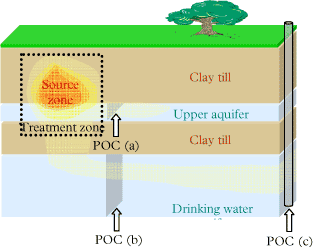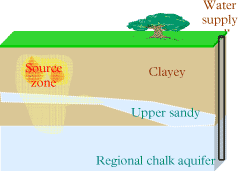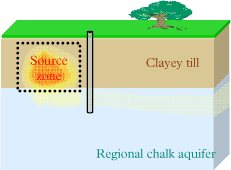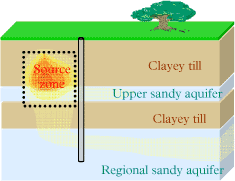Model assessment of reductive dechlorination as a remediation technology for contaminant sources in fractured clay: Case studies
2 Modeling and remediation objectives
2.1 Aim of modeling
The overall purpose of the modeling tool is to assess the performance of enhanced reductive dechlorination (ERD) as a remedy for contaminated low permeability media.
For each of the test sites, the model will be used to provide information on the temporal development of three important performance metrics:
- residual source mass
- contaminant mass flux out of the source zone
- average source zone concentrations
The performance metrics will be evaluated for a number of different remediation scenarios representing different situations in terms of distribution of bacteria and substrate in the subsurface. The remediation scenarios will be compared to a baseline scenario without enhanced dechlorination.
The model consists of two components: a model of the fractured clay system containing the contaminant source; and a model of the underlying groundwater aquifer. The contaminant flux from the fractured clay source model is input to the aquifer model in order to estimate the expected aquifer concentrations in either a upper or regional aquifer depending on the remediation objectives for the specific site.
Given the remedial objectives for a site, the model is used to assess the timeframe for achieving the desired cleanup level. This requires that a clear and operational termination criterion for the site cleanup has been set, which is not always the case in real life applications (Miljøstyrelsen 2008b).
To address parameter uncertainty, a number of sensitivity scenarios will be presented for one of the sites. In the sensitivity analysis, the sensitivity of the various parameters e.g. fracture spacing and degradation rates is assessed by examining the effect on the calculated mass removal and contaminant flux.
2.2 Remedial objectives
Remedial objectives must be defined before commencing treatment of contaminant sources such as clay till source zones.
The task is not as straightforward as it is for groundwater plumes in aquifers, where compliance with groundwater quality criteria can directly be used as a remedial objective. In-situ remediation of clay till source zones eventually results in compliance with objectives of groundwater quality, but as there is a delay before an aquifer experiences the impact of source zone remediation, groundwater cleanup criteria are less useful for determining when a source zone treatment can be terminated.
In the following section a framework for setting of remedial objectives is presented. This is followed by a presentation of the existing remedial objectives for the three case studies used in this report.
2.2.1 Absolute objectives and functional objectives
Following the nomenclature of ITRC (ITRC 2008), remedial objectives can be either absolute or functional. Absolute objectives describe the overall goals of remediation and represent social values such as protection of human- or ecosystem health and preventing deterioration of groundwater resources. Each absolute objective should be accompanied by a number of functional objectives that are means by which the absolute objective is achieved. A functional objective should be equipped with a quantifiable performance metric which can readily be measured; alternatively the functional objective can be broken down into subsidiary measurable objectives.
As an example, consider a contaminated site with an absolute objective of protecting the groundwater resource. The contaminant source is located in a low permeability clayey till overlying a groundwater aquifer used for drinking water extraction. An upper aquifer not used for drinking water extraction is also present. The conceptual site model is presented in Figure 2.1.
A common functional objective for such a site is the compliance with groundwater quality criteria at a certain point of compliance. Possible points of compliance are: (a) the upper aquifer at the downstream boundary of the treatment zone; (b) the regional aquifer at the downstream boundary of the treatment zone; and (c) the regional aquifer at a downstream receptor (drinking water well, receiving water body).

Figure 2.1 - Conceptual site model for setting of remedial objectives. Possible locations for point of compliance (POC) with groundwater quality criteria are indicated.
Since source zone remediation does not affect groundwater concentrations immediately, quality criteria cannot be used directly to guide the remedial action taken in the source zone. In order to have an operational termination criterion it is therefore necessary to define a subsidiary functional objective for the source zone, where the effect of remediation is monitored.
Thus we will advocate for the use of two complementary functional objectives in the case of source zone remediation:
- Long term functional objective: To comply with groundwater quality criteria at selected point of compliance in the groundwater. Performance metric: groundwater concentration (µg/L).
- Source zone functional objective: To reduce the source zone contamination to a level that ensures that the long term functional objective is met. Performance metrics: total[1] soil concentrations in source zone (mg/kg), source zone aqueous concentrations (µg/L), and contaminant mass flux from source zone (kg/yr).
Objective 2 can be seen as a termination criterion for the source zone treatment, whereas objective 1 is a termination criterion for the post-remediation monitoring.
Setting of a source zone termination criterion requires that modeling of the contaminant attenuation from the source zone to the chosen point of compliance is carried out.
The termination criterion for the source zone is ideally defined in terms of the total (or percentage) mass removal, as this is a more reliable metric than aqueous concentrations when it comes to assessing the extent of residual contamination left in the source zone. Continuous monitoring via soil cores is not typically conducted during site remediation as it is more practical and economically feasible to monitor via water sampling. A termination criterion expressed in terms of aqueous contaminant concentrations in the source zone, should preferably be accompanied by a total soil concentration criterion. When the termination criterion for the aqueous phase has been achieved, the next step is to investigate the compliance with a termination criterion defined by total soil concentrations.
Another possible performance metric for defining a termination criterion is the total contaminant mass flux leaving the source zone. This definition requires that a procedure for determining the site-specific mass flux is available i.e. via multilevel sampling along a cross-section directly downstream the source zone.
Prior to the commencement of the remediation, it is essential to establish a baseline for each of the performance metrics used (contaminant mass in source zone, total contaminant concentrations in source zone, contaminant mass flux from the source zone). This makes it possible to evaluate the changes in the contaminant situation at the site.
2.2.2 Remedial objectives at Vadsbyvej
A conceptual sketch of the Vadsbyvej site is presented in Figure 2.2. In the risk assessment for Vadsbyvej (Region Hovedstaden 2008c) the absolute objective of a remedial action at the site is defined to be the protection of the groundwater resource to ensure its future use as a source of drinking water. There are no risks related to the present land use and no surface water receptors at risk.

Figure 2.2 – Conceptual sketch of the Vadsbyvej site. The remediation objective for the site is based on complying with quality criteria in the abstracted drinking water at the water supply well 500 m downstream from the site.
The risk assessment concludes that at present there is no acute risk of contamination of the drinking water abstracted at the nearby well field. Based on the elevated contaminant concentrations in the source zones it is, however, anticipated that there will be a significant risk in the future. As the upper sandy aquifer is hydraulically connected to the regional aquifer in the downstream direction, the two aquifers are regarded as one interconnected aquifer in the risk assessment.
A long term functional objective is defined as complying with the drinking water quality criteria for the groundwater abstracted at the downstream water supply. Based on this long term objective, a criterion for the short term has been defined as the maximum mass flux in the upper sand aquifer that satisfies the long term criterion. This is combined with a criterion for the maximum concentration of vinyl chloride in the sand aquifer. Thus the two short term functional criteria that in combination define the termination criteria for a successful remediation are (Region Hovedstaden 2008c):
- to obtain a stationary or decreasing contaminant flux in the upper sand aquifer compared to the baseline of 10 g/year (sum of chlorinated solvents: chlorinated ethenes and ethanes, ethene/ethanes are not included in this sum)
- to obtain a stationary or decreasing concentration of vinyl chloride in the upper sand aquifer compared to the baseline of 60 µg/l.
These objectives are irrespective of the choice of technology for remediation. Furthermore a temporary increase in both contaminant flux and concentrations can be accepted during treatment (Region Hovedstaden 2008c).
The baseline flux was estimated from (a) a volume pumping of a well downstream from the hotspots and (b) a mass flux calculation based on contaminant concentrations in four wells and assignment of a representative cross-section area to each well. A homogenous flow field (hydraulic conductivity and gradient) in the upper aquifer was assumed and the hydraulic conductivity was estimated using pump test data.
The existing remedial objectives for Vadsbyvej can be used together with the models to assess the time horizon for cleanup. However, as the modeling tool only handles chlorinated ethenes and not chlorinated ethanes, the flux criterion is reduced to only represent the contaminant flux of chlorinated ethenes which according to the flux calculations in (Region Hovedstaden 2007) constitutes approximately 20% of the total contaminant flux from the site. The existing termination criteria could be strengthened by combining it with a criterion considering the total soil concentration in the source zone.
2.2.3 Remedial objectives at Gl. Kongevej
As for Vadsbyvej, the absolute objective of remediation is to protect the drinking water aquifer. The drinking water aquifer at Gl. Kongevej is approximately located only 9 meters below the surface and has already been significantly contaminated. A sketch of the Gl.Kongevej site is seen in Figure 2.3. In 2004 it was suggested that the contaminant flux from the source zone was to be reduced by a factor of 100 as concentrations of up to 70 µg/L (sum of chlorinated ethenes) was found in the regional groundwater. In addition to this, a termination criterion of 10 µg/L (sum of chlorinated ethenes) in the source zone porewater was suggested (Miljøkontrollen 2004a).
Later investigations measured concentrations of up to 3100 µg/L (sum of chlorinated ethenes) in the drinking aquifer (Miljøkontrollen 2005). In 2006, in-situ stimulated reductive dechlorination was initiated at the site and a number of revised functional objectives were formulated (Miljøkontrollen 2006). A short term functional objective was set to be the achievement of stationary or decreasing concentrations (and flux) of chlorinated ethenes in the drinking water aquifer within 5 years from initiation of the treatment. An actual termination criterion was suggested to be the reduction of concentration levels in the treatment zone with a factor of 50 as this would give an equivalent reduction in the contaminant flux to the aquifer.
As this termination criterion is a rough estimation we will investigate the necessary cleanup level further by using the modeling tool. Hence for the purpose of the performance modeling in this report, a functional objective of complying with groundwater quality criteria is used and a point of compliance is chosen at the downstream boundary of the treatment zone in the drinking water aquifer (POC (b) in Figure 2.3). A termination criterion for the source zone is then assessed by a combined use of a source zone flux model and an aquifer model.

Figure 2.3 - Conceptual sketch of the Gl. Kongevej site. The proposed long term remediation objective is to comply with quality criteria in the regional aquifer at the downstream boundary of the treatment zone. The treatment zone is indicated with the dotted black box.
2.2.4 Remedial objectives at Sortebrovej
At the Sortebrovej the source zone is located in at clayey till layer overlying an upper aquifer, which is also significantly contaminated (see Figure 2.4). The clayey till source zone has a significant number of sand lenses and -stringers from which groundwater is monitored during remediation. The absolute objective at Sortebrovej is to protect the groundwater resource. As for Gl. Kongevej a short term objective is to achieve stationary or reduced concentration levels of chlorinated solvents in the regional aquifer within 5 years of the start of remediation (Fyns Amt 2006a). A termination criterion was initially suggested to be the reduction of source zone concentrations with a factor of 50-100 (Fyns Amt 2006a). The remediation objectives for Sortebrovej were revised and further specified in 2008. The long term functional objective is defined as to comply with groundwater quality criteria at a point of compliance in the regional groundwater at the downstream boundary of treatment zone (Region Syddanmark 2008a). As the effect on the aquifer is delayed in time, this long term objective is combined with a termination criterion based on source zone concentrations. The criterion for termination of the treatment is to reduce the average aqueous concentrations in the high permeable structures in clay till source zone to 100 µg/L (sum of chlorinated ethenes). The baseline concentration level in this aquifer was found to be 11 000 µg/L. The compliance with the termination criterion is to be reflected in 3 adjacent monitoring rounds conducted over a minimum of one year to avoid contaminant rebound. The average concentration is evaluated based on 13 monitoring wells screened in the source zone. It is also suggested that soil core sampling is conducted to assess the actual mass removal in the clay till (Region Syddanmark 2008a).
The chosen termination criterion of 100 µg/L for the aqueous source zone concentrations is based on the assumption that the contaminant levels will be reduced by a factor of 100 due to attenuation in the intermediate clay layer and via dilution in the regional aquifer. This assumption will be investigated by expanding the model for Sortebrovej to include the intermediate clay layer and the regional sand aquifer. The termination criterion for the source zone will be revised based on the modeling results.

Figure 2.4 – Conceptual sketch of the Sortebrovej site. The long term remediation objective is to comply with quality criteria in the regional aquifer at the downstream boundary of the treatment zone. The treatment zone is indicated with the dotted black box.
[1] i.e. including contaminant both in the water phase and in the sorbed phase
Version 1.0 July 2009, © Danish Environmental Protection Agency